4 Tips Every Landing Page Can Use To Get You Leads
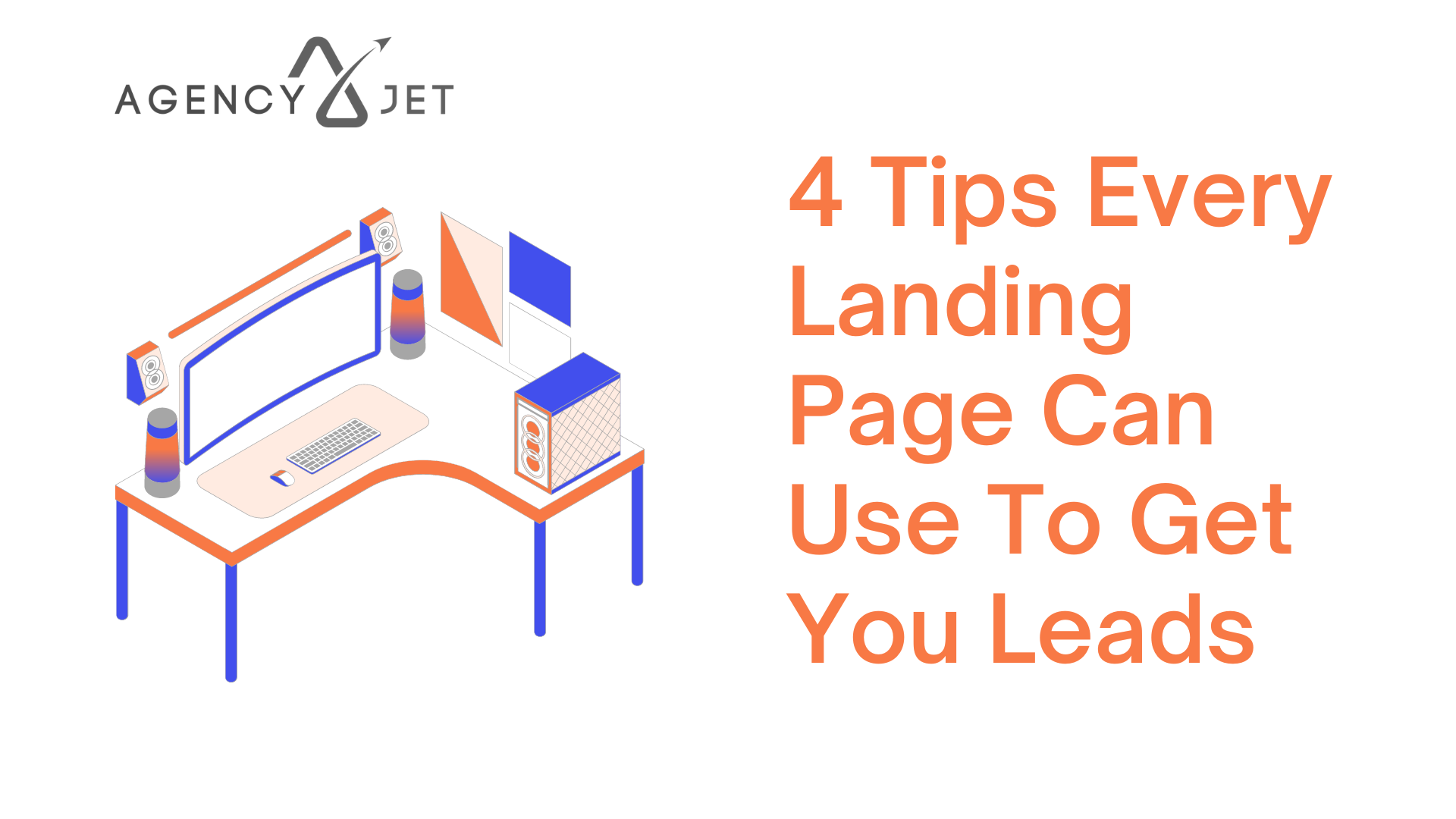
If you’re a small business owner, you’re probably wondering why your website isn’t bringing in the leads you’re expecting.
It may be due to poor website design or the lack of a good landing page. There’s no better time than now to create your landing page; ensure that it will deliver on the following:
- Speak to your target audience
- Be simple but effective
- Offer something valuable
- Be easy to use and navigate
Some specialists can help you landing page optimization, but before you go that far, try optimizing your website and landing page yourself first. It may be all you need to do to start generating leads.
In this blog post, we share everything you need to know to create an effective SEO landing page and user experience. We also explore what search engine optimization is, what a landing page is, why it’s useful, and leave you with four tips to make your landing pages better.
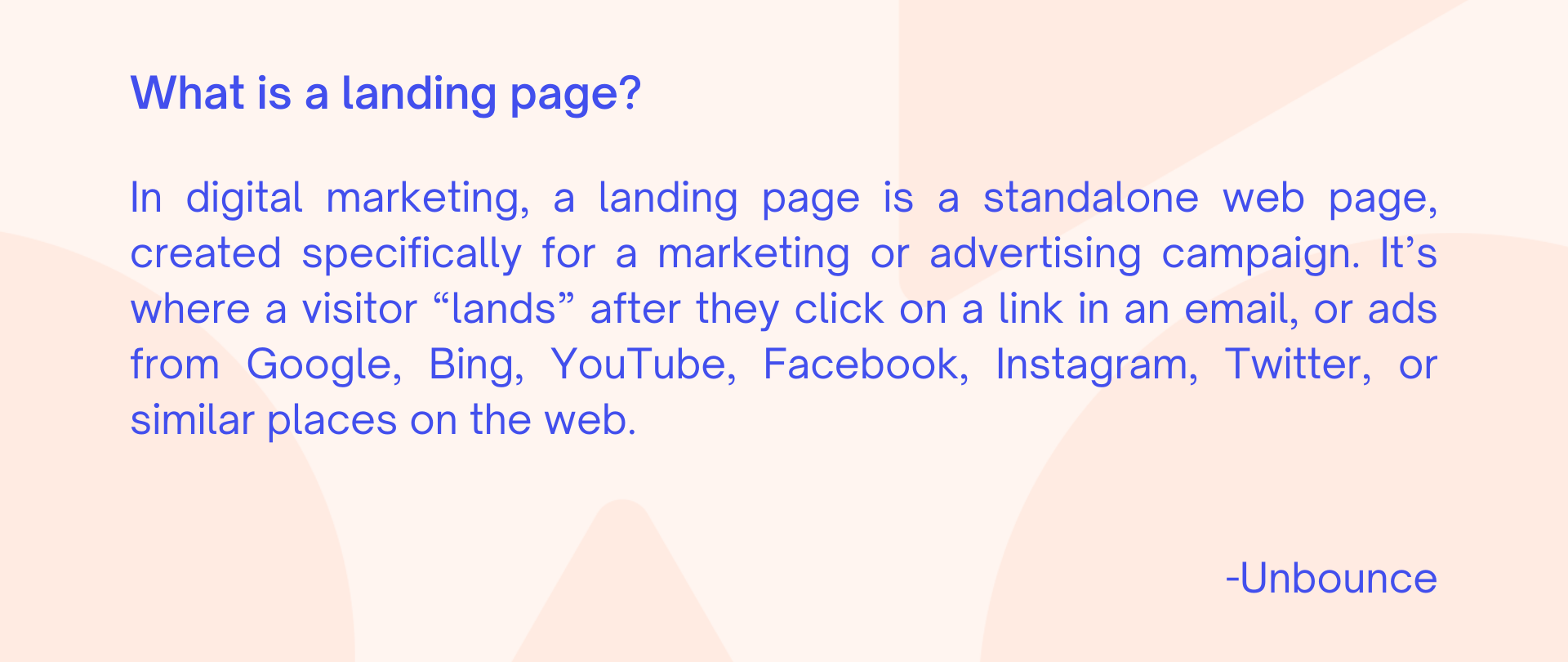
What Is an SEO Landing Page?
Landing page URLs are specific web pages that contain a target keyword that may prove to be valuable or suitable for SEO ranking.
These pages also contain a call-to-action or CTA, and will generally be part of a larger marketing campaign used by companies and businesses. An SEO landing page aims to increase the total traffic for your website from organic search and it can work in a variety of different ways.
You’ll be able to spot a landing page by its most obvious trait, which is a type of form that asks for your details, including your name, address, birthday, etc.
These are designed to gather information from visitors, and thus can create a clear picture of potential leads and what they’re looking for, which helps businesses provide a better experience for users. There are also different kinds of landing pages, such as a local SEO landing page or a regional SEO landing page.
How Does Using SEO for Landing Pages Create Leads?
Working on SEO for landing pages can help to drastically improve your lead generation by increasing your company’s visibility and making it accessible to a wide range of qualified prospects.

By following the best practices below, your website’s content can be more readily found anywhere online. Your SEO campaigns will always be updated through unique keywords that immediately point to you and your services.
It is impossible to separate lead generation from SEO. SEO increases your online visibility and search traffic; if no one sees your content, you can’t generate or convert leads. This is also true for small businesses, where you can attract different types of leads, such as:
- Email lists
- Phone numbers
- Addresses
- Social media profiles
- Quick quotes for service-oriented businesses like cleaners, landscapers, drywallers, and more
However, if the keywords you choose fail to rank in SERPs, your website won’t be seen by your audience and you won’t get the leads you’re after, no matter how amazing your company is.
What’s the Strategy Behind Landing Page SEO?

The beauty behind landing page SEO is that you won’t have to choose between your conversion rates and ranking.
You’re free to create a piece of content that is more focused on conversions, SEO, or both, to help your customers get further down your funnel. For example, if you wanted to develop a more SEO-focused landing page for selling financial software, you can target specific keywords that focus on purchases, such as “budgeting software” or “personal finance software.”
These are the kinds of keywords that people will generally use when looking to buy such software. You’ll be able to prove this to yourself simply by going on Google and looking through search results for the same keywords.
By using SEO-optimized landing pages, you can also use more intuitive keywords such as “how to save money” or “how to start a budget” where you can direct your visitors toward conversion-focused pages.
You’ll be able to see the difference in your search results, and because your SEO-focused landing page will have more content to show, you’ll be able to move on from primary keywords to long-tail keywords.
Remember that the keywords you choose will play a huge factor in how much SEO traffic your website will be able to convert. For example, looking up “how to save money” won’t attract as many leads compared to “how to budget” since the first option will have broader results than the second option.
As a result, you will need to be careful with the words you choose. Now that we’ve got the basics of landing page SEOs, here are four things every landing page design needs to get you leads.
Tip 1: Your Keyword Strategy Needs to Guide the Content
We cannot stress enough how important primary keywords are. Because of this, you can’t expect this part of the journey to be easy — this is probably the most time-consuming part of improving your landing page.
Around 70% of all search queries use long-tail keywords, which is why it’s important to create your strategy around them.
To get started, it’s best to break down what you’ll need to do to achieve the results you’re after.
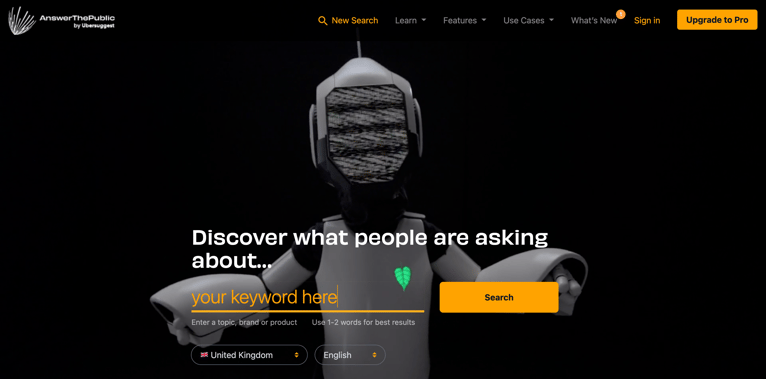
Not sure where to start on your keyword finding journey? Answer The Public is a great place to start. Type in what you do and see what people are asking. Then use other tools to confirm if there's enough search volume there to form a landing page strategy around it.
Brainstorming Broader Ideas
While it may sound counter-productive, the first thing you need to do is to get as many broad keywords as possible, while still keeping the focus on your industry and business. For example, if your business provides resume writing services, you would want to brainstorm keywords such as:
- Cover letter writing
- Resume writing
- Best resume writing services
- Buying resume
- Buying cover letters
- Professional resume writers
- CV writing services
Be sure to use these keywords to start getting more and more specific to eventually come up with long-tail keywords that are closely related to the services you offer. Be sure to use these primary keywords logically and naturally throughout your content, explaining more complex or niche concepts — remember that you have a human audience, so don’t expect them to understand words that are too technical.
Keyword stuffing won’t work either, because today’s search engines can recognize this and will only hurt your efforts to climb up the SERPs.
Tip 2: See What Competitors Are Doing and Improve on It
To ensure that your landing page improves exponentially, you can look into what landing page elements your competition might be using. Whether they’re right next door to you, or a whole state away, there are many ways in which you can see what your competitors are up to.
Check Out Their SEO Strategy
If you want to know exactly how your competition operates, you can reveal hidden pages by searching Google for a “file type: doc site; company name.” You’d be surprised by just how much data can be revealed by changing the file type. You can also go straight to a competitor’s website and use tools from Google Trends, Google Alerts, and AdWords campaigns.
Look for Their Strengths and Weaknesses
Today, companies can monitor, track, and engage people through social media platforms to help them reach their goals. To become successful, you will need to use written and measurable marketing analysis to stay in the loop about your competition’s key areas—inside as well as outside their social signals.
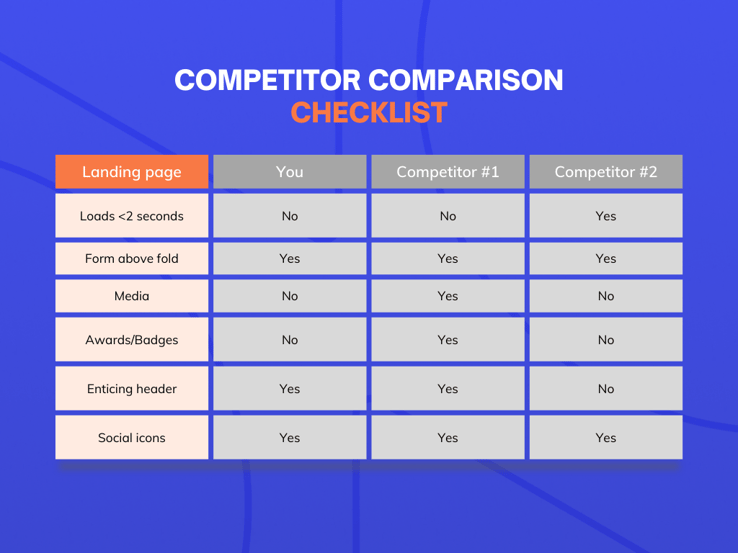 It's never a bad thing to see what the competition is up to. Here's a simple comparison chart example that shows areas of improvement for your landing pages versus your competitors.
It's never a bad thing to see what the competition is up to. Here's a simple comparison chart example that shows areas of improvement for your landing pages versus your competitors.
Be sure to look for the following factors whenever you’re looking into other companies that offer the same products and services as you do:
- Platforms: Where are they active? Facebook, LinkedIn, Twitter, Instagram, Pinterest, and even TikTok and YouTube are some of the most popular social media platforms that businesses leverage.
- Frequency: How often do they post? Once a week, once a month, or daily?
- Content: What kind of content do they post? Are they promoting offers, creating blogs, or looking for connections? Be sure that you post content that is as relevant to your industry as possible.
- Following: How many followers do they have? The more people that are engaged, the more you’ll know that their strategy is working. Build from their foundation and make it even better.
- Response time: How quickly do they respond to their customers? Be sure that you provide the best customer service, even after the sale is finished.
From a social perspective, when it comes to designing a landing page, it's important that you include social share buttons and access to your profiles. By doing so, you're showing the true expanse of your digital footprint and helping those who land on the page engage with you further.
Learn Their Content Strategy
The value that people find in your informative content can be all that stands between your business failing or succeeding. People want to know that they can take something away after reading your content, but it can be difficult to measure the value that content can offer.
However, there are a few things you can look for to check how well your high-quality content is doing against your competitors:
- The type of content: Is it a blog, website copy, e-book, follow-up email, or downloadable PDF? Be sure to look up what’s currently trending.
- How often you publish: Just like social media, you need to be consistent with how often you post your content. Be sure to do a content analysis by checking how often your competitors are publishing content and create a strategy of your own that does better than they do.
- Quality of content: Be sure to read their content and see if it is well-polished or sloppy — check if it is well thought out or if it seems rushed.
- How relevant it is: If you see that your competitors constantly publish content that isn’t about their products or services, then be sure to do the opposite. Always aim to highlight why your products and services are superior.
- Who is their audience: If you already share the same audience, look into their following and position yourself as the better company and you’ll be able to get some of their followers.
Tip 3: Design it to Fit the Searcher's Intent
Search intent (also known as audience intent or user intent) refers to having a purpose during an online search. This is the reason why someone is conducting a specific search on Google or another search engine.
However, there are many different reasons why a person would go online to look for something, and they will often represent different stages, such as:
- Informational intent
- Navigational intent
- Transactional intent
- Commercial investigation
However, it’s not enough that you’re familiar with these concepts — you need to know how to design your website to fit the intent of your visitors as well as appeal to search engine algorithms.
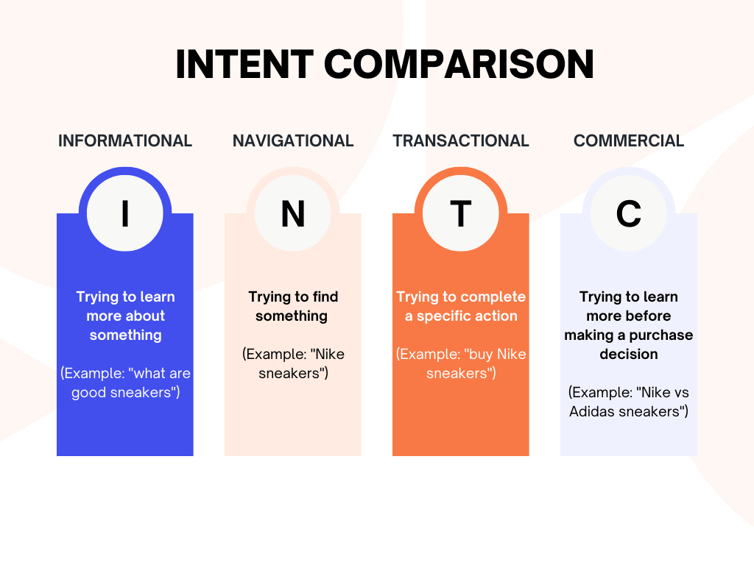 You can get started by optimizing your product pages using commercially-driven keywords. At the same time, you can hurt your chances of converting a sale if you show a page of your products to someone that is looking for information and would prefer a blog or educational content that explains what you offer.
You can get started by optimizing your product pages using commercially-driven keywords. At the same time, you can hurt your chances of converting a sale if you show a page of your products to someone that is looking for information and would prefer a blog or educational content that explains what you offer.
It can be hard to determine a query’s search intent, but you can use a direct source to help you figure out which keywords fit the kind of intent: the search results page.
Additionally, you can also ask your audience about their intent through a short survey, where you can ask questions that answer what they’re looking for whenever they visit your site.
Be sure that you make this a friendly experience for your guests — you don’t want to be too pushy with your questions, so keep things laid back.
The point of fitting the searcher's intent is really quite simple. By having high-quality and keyword-rich content (that doesn't overdo it) you'll be sending a direct signal to search engines to place you for these important keyword phrases.
Once Google, Bing, Duck Duck Go or some other search engine starts placing you on the top pages, you'll be driving organic search traffic directly to your site for something the user was looking for specifically.
From there, you simply need to make sure you have a friendly landing page that is engaging and gives people a chance to convert. You can have all the SEO ranking factors in the world to help you get found but if the landing page isn't easy enough or appetizing enough for the user, you'll be wondering where your leads are.
But you don't just create an awesome landing page and then you're done. Nope. You need to make sure you're seeing how well it works.
And for that, you'll need to look at some stats.
Tip 4: Analyze the Stats for Your SEO Landing Page
This is the last and probably most overlooked step in improving your landing page conversions.
Most people will underestimate just how powerful SEO analytics can be — a big reason why some businesses fail. Free tools such as Google Analytics can help you track, measure, and enhance your SEO efforts.
Moreover, there are many different ways you can use and leverage the data contained within Google Analytics, so you’ll have more chances and methods to use for business development. When you’re ready to get started, remember that the most important factors are your click-through rates and organic traffic.
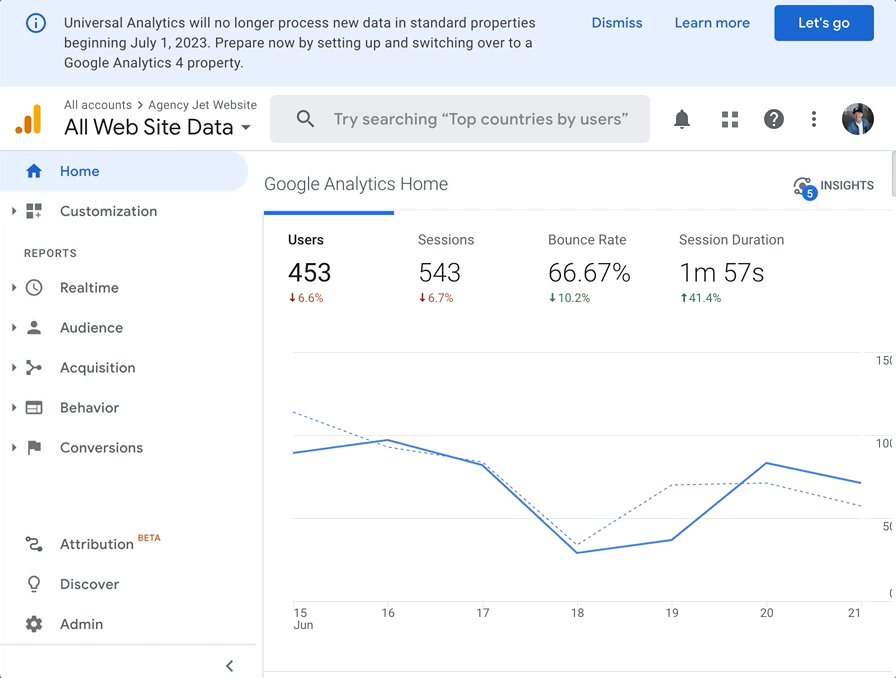
Here’s how you can start tracking them:
- Click through to “Acquisition”
- Go to “All Traffic” via the sidebar
- Click “Channels”
- Choose “Organic” and set the dates you need to look at
- Set a filter according to the specific landing pages you’re after
Depending on how well your website is doing, you can make small adjustments or, if needed, hire an expert to get more organic traffic and conversions.
Google Analytics, or tools like SEMrush, Google Search Console or Google PageSpeed Insights, will help you tremendously determine how well your landing page is performing.
With these tools you can look at bounce rates, the page load time, how many inbound links the page is getting, how many outbound links is giving, how responsive the page is and how it fits to all screens and other aspects of technical SEO that will help the page perform.
In short, analyzing the performance of the page will determine if it's an effective landing page or not. The point of the page is to get found and then convert visitors. Using a variety of tools will help you do that.
But tools can get overwhelming if you're not initiated to the digital marketing world. That's why a two-hour free and educational website audit can help tremendously.
Conclusion
Two things are certain when it comes to SEO for landing pages: It has to be properly optimized so it can be found by searchers who are intent on making a purchase, want to subscribe to your newsletter, or are looking to sign up for your services, and it has to be extremely easy for those users to fill out and submit their information.
Without these two absolutes, optimizing your website landing pages with SEO will falter and won’t yield the conversions you're looking for.
Luckily, Agency Jet offers a free and educational website audit that will help identify the strengths and deficiencies of your company’s website. We also offer a whole host of SEO campaigns through local SEO services, regional SEO services, national SEO services and more to ensure that you get the results you’re looking for.
Contact us to learn how Agency Jet provides some of the most affordable small business SEO services in the United States.
